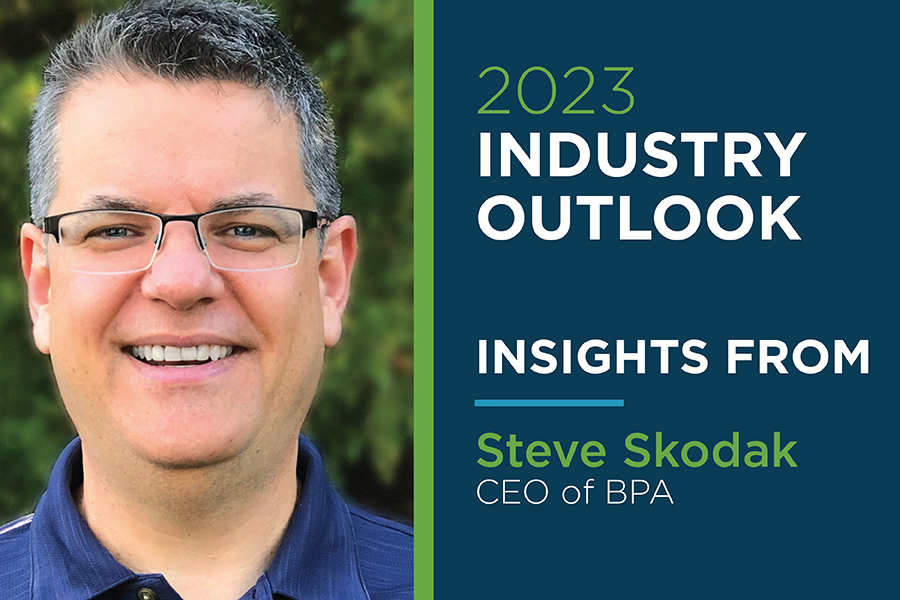Jan 17, 2023
2023 is the Year of Growth
Steve Skodak, the CEO of BPA, shares his 2023 outlook for the home and building performance industry.
By: Steve Skodak

Mark my words: 2022 was the year our industry was changed. 2023 is the year we’ve worked toward. This is the year we’re ready for. This is the year we grow.
The successful passage of the Bipartisan Infrastructure Law (BIL) and Inflation Reduction Act (IRA) in 2022 has set the stage for the year ahead to be one of preparing for implementation and growing the capacity of the energy efficiency retrofit market nationwide. The Building Performance Association (BPA) will be working to support the work of the National Association of State Energy Officials (NASEO) as they work with the Department of Energy (DOE) to provide guidance to the State Energy Offices (SEOs) on implementation of these two pieces of legislation.
Currently, BPA is working on providing responses to the Request for Information from the DOE on implementation of the portion of the IRA that addresses home retrofits. BPA, along with over 20,000 members of the industry, are working to provide insight on how national policies play out at the dining room table of Americans as they contemplate improvements to their homes.
Through IRA, new federal income tax credits are available through 2032, providing up to $3,200 annually to lower the cost of energy efficient home upgrades by up to 30%. Improvements such as installing heat pumps, heat pump water heaters, insulation, doors and windows, as well as electrical panel upgrades, home energy audits and more, are covered by the tax credits and can help families save money on their monthly energy bills for years to come.
In addition to the energy efficiency credits, homeowners can also take advantage of the modified and extended Residential Clean Energy credit, which provides a 30% income tax credit for clean energy equipment, such as rooftop solar, wind energy, geothermal heat pumps and battery storage through 2032.
According to a DOE fact sheet, the IRA will help drive 2030 economy-wide greenhouse gas (GHG) emissions to 40% below 2005 levels.
Following guidance from DOE to SEOs, those offices will need to determine how they will be executing and offering these programs within their state. BPA will be working with SEOs to educate industry stakeholders on how to implement programs in accordance with each state’s process. BPA will offer training to contractors that will help them take advantage of the programs and learn how to build successful, sustainable business models.
BPA will continue to encourage new individuals to join our industry by promoting well-paying jobs and highlighting options for a great career in the clean energy economy. BPA is also working with Affiliate and Ally networks in each state to bring attention to those groups, such as Goodwill Industries, offering workforce development opportunities within the building science world. BPA will highlight these programs and support them using resources within our network to scale programs and encourage more participation in our industry.
2023 will be a year of scaling for all in our community. BPA, along with our network, will be implementing DOL-approved apprenticeship programs for home retrofits and contractors looking to hire and train employees on-the-job. The apprenticeship program opens the doors for candidates and contractors to receive national and state incentives to put people to work. These programs call out the ongoing need for better diversity, equity, and inclusion processes, which are essential to the growth and success of our industry.
According to an E2 analysis of U.S. Department of Energy jobs data, more than 3.2 million Americans were employed in renewable energy, energy efficiency, storage and grid modernization and clean fuels at the end of 2021. That analysis also noted that while clean jobs grew along with most of the rest of the economy in 2021, they are still well below their pre-COVID peak, in part because of lingering uncertainty around federal policy.
According to BW Research commissioned by The Nature Conservancy, the IRA will create nearly 537,000 jobs per year for a decade. Needless to say, there’s a lot of work to be done in anticipation of national funding that can be used to train workers to join our industry and, ultimately, meet the national and state administrations’ targets for efficiency—but BPA and its members are ready. BPA’s goal is to support those currently working on these issues and provide support to help grow capacity.
We can do this together.






